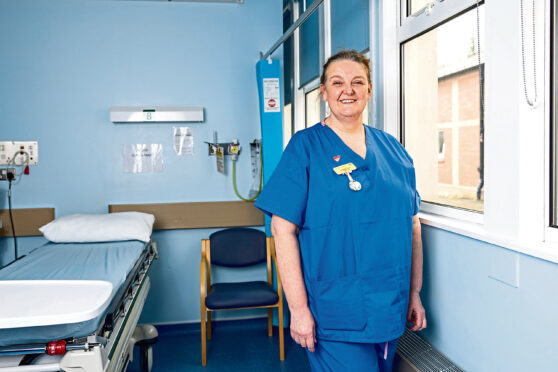
Her job at a Scottish hospital involves screening patients for cancer.
But nurse Lorna Gray has taken the fight against the disease to a new level – by twice donating stem cells and saving the life of a dying young boy.
The 54-year-old grandmother who works at the Vale of Leven Hospital in Alexandria, West Dunbartonshire, signed up as a donor with stem cell matching charity DKMS, thinking she may be called one day to donate.
Just three months later, when she was on holiday in the Canary Islands, she received a call from the charity who asked to make her way to a London hospital where the donation was made.
Remarkably, she donated 42 million cells in her first donation, rated by DKMS as excellent. The young boy improved amazingly well but became ill again two years later and last December his doctors put out another SOS call to the life-saving nurse and she travelled to London again to give a donation.
“It is wonderful being able to save the life of a desperately ill child in need of a matching donor,” she said. “Giving stem cells costs nothing and all I am giving is my time. Donors are the last hope for many patients dangerously ill with diseases like blood cancer.
“As for the outcome, my recipient required a target cell count of five million. My 300ml donation yielded 42.73 million cell count.
“Being able to keep this young boy alive is the best feeling ever and not all that removed from working with patients being screened for cancer at my hospital. It’s all about intervening early and working to save lives. I did not think I would be called on to donate once, but twice is very unusual.
Looking back to the first phone call from the charity, she says: “When my phone rang during my holiday to Tenerife, I ignored it thinking it was a spam call but then picked up the charity’s message urging me to get in touch. I called them back immediately.”
She received a letter saying the child had improved and a thank-you letter from his mum. Then, weeks later, a second SOS arrived for her to donate and she travelled to London again to donate.
“I’m an emotional person at best, so this journey has had a few tears along the way but seeing that wee bag of stem cells brought only tears of achievement and hope for some kind of future for the recipient,” she said.
The rules of stem cell donation mean the Alexandria nurse is not allowed to meet the child until two years after her last donation. She has received a letter from his mother saying that he has improved.
DKMS is the UK arm of a German blood donor matching charity that creates and matches an international pool of donors that gives blood cancer patients a chance to live.
Sadly, some patients die without finding a match. Lorna is part of a Scottish supporters’ group that recruits donors.
Steve Macmillan, who set up the Scottish hub, said: “I did this after reading about a little girl of two who had blood cancer and needed a donor. I felt there was very little presence or awareness in Scotland but we are changing this. We now have a small team who have either received or donated stem cells during the battle with blood cancer and lives are being saved.”
Donors of African, Caribbean and other black heritage are always in high demand as there are some illnesses, such as multiple myeloma and sickle cell disease, that disproportionately affect people from these backgrounds, says DKMS.
If you’re 17-55 years old and in general good health, please consider requesting a swab kit via the DKMS website.

Enjoy the convenience of having The Sunday Post delivered as a digital ePaper straight to your smartphone, tablet or computer.
Subscribe for only £5.49 a month and enjoy all the benefits of the printed paper as a digital replica.
Subscribe